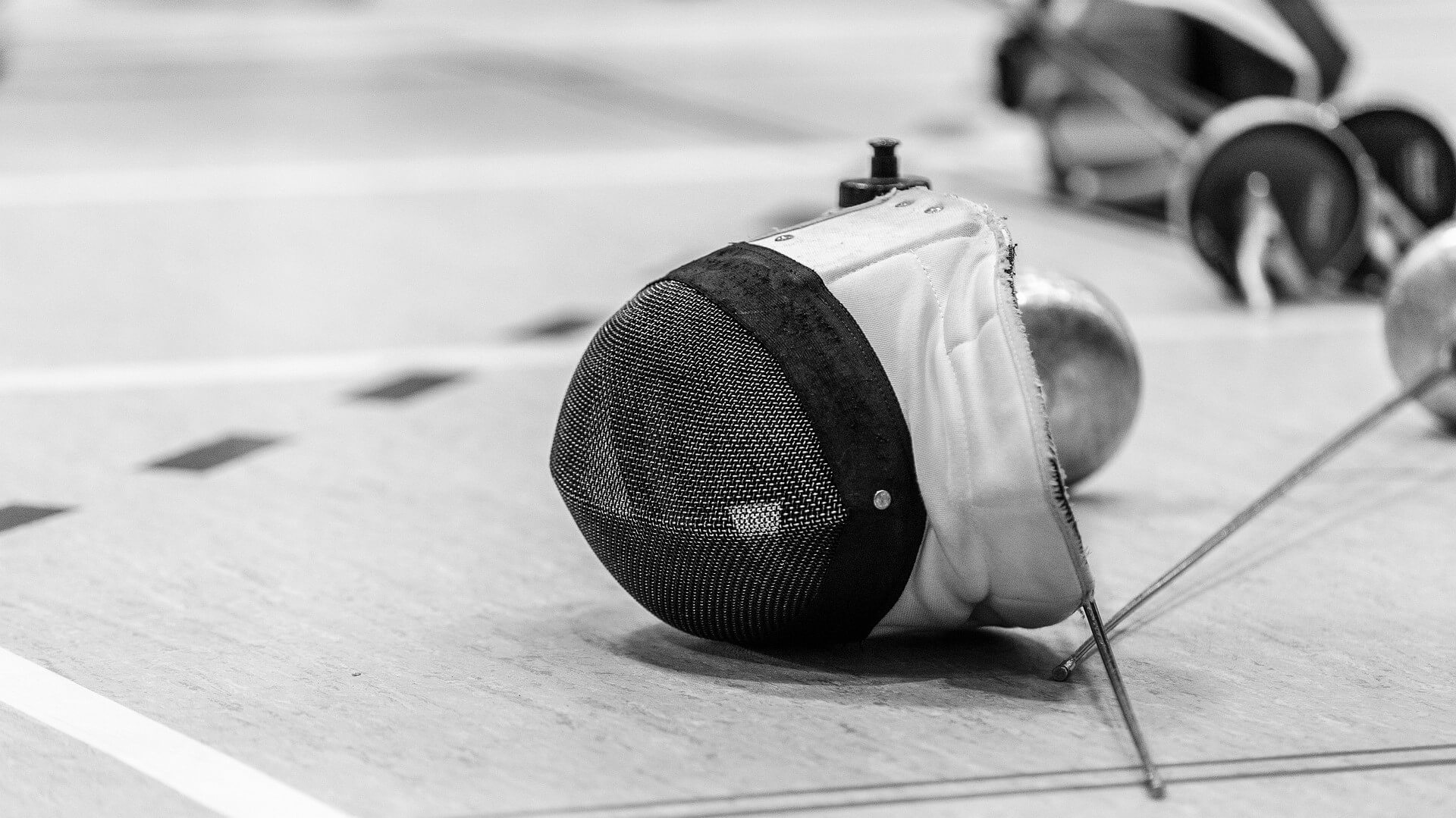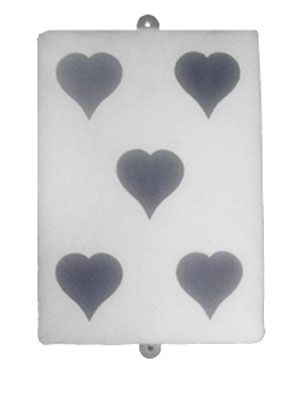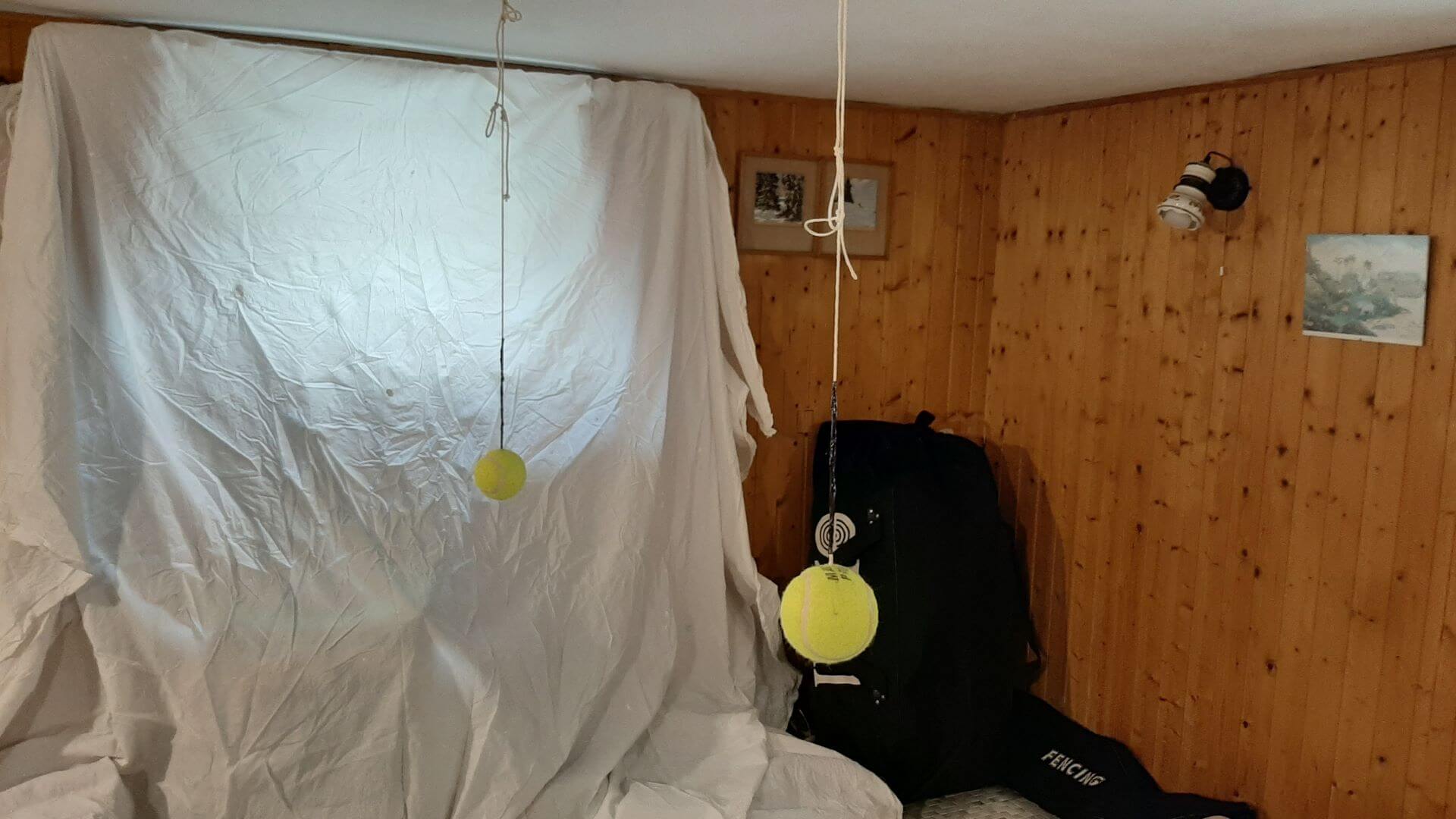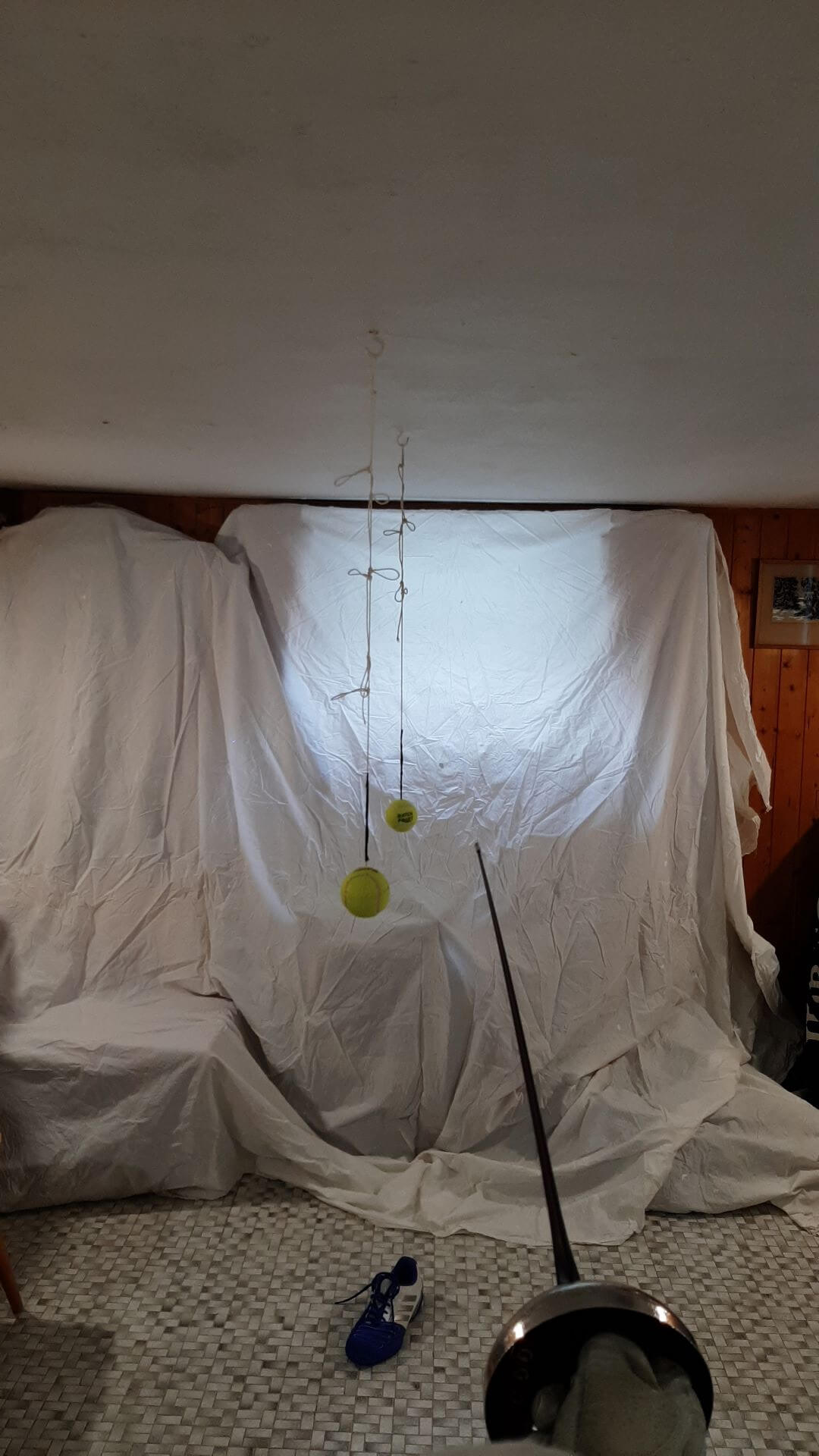
Fencing Training at Home – Epee blade exercises
Regular training is essential to improve at anything and fencing is no different. Few fencers have the luxury of training at a club more than once or twice a week so training at home is an essential tool to develop your fencing. This guide will help you develop your sword in hand skills and so naturally you will need access to some equipment at home.
Fencing is like a conversation with a natural flow and interaction between both sides, which is impossible to fully replicate on your own at home. These exercises are not meant as a substitute for a lesson with a coach but they are an effective way to practice when your coach is not available. A good coach can quickly spot and correct mistakes and adapt the exercises to enable you to break movements down or make adaptations to offer new challenges.
When training at home try to be your own coach. Always focus on developing and maintaining good fencing form and consider how the exercise you are performing translates into the real fencing scenario. If you just train to hit a tennis ball, you’ll get good at hitting a tennis ball but not necessarily your opponent!
Practice does not make perfect, it makes permanent. Value the time you invest by always training with the intention to do your best. Any new skill takes practice and when you try something new performance will often initially drop. Be patient, learn from failure and commit to trying again.
These exercises and coaching points are provided to support your training but with the expectation that you have taken at least some instruction with a coach. Please note they are not an exhaustive list and in fencing, different things work for different people. If you have any questions, discuss them with your coach or contact me.
“Don’t train until you get it right, train until you can’t get it wrong!”
General Coaching Points
Distance
Good distance is essential. It is important to practice hitting a stationary target from different distances in order to develop your perception of distance and control of steps and lunges.
When hitting, aim to have some bend in the blade but not extreme. A good way to judge your distance is to practice simple extensions, steps and lunges past a fixed point. You could cut a hole or a series of holes in the front of a cereal box then tape the box to a wall at chest height. Extend/attack to put the tip within the hole. Touch the edge of the hole and your accuracy needs work, hit the back of the box and your distance needs work.
Reposting distance is the most difficult distance to hit with accuracy since your arm is a fixed length and as you extend your arm, the point does not move in a straight line. With steps and lunges it is simple to adjust the distance you travel and once the arm is extended, the point should move in a fairly straight line making it easier to maintain accuracy. It is important to learn not only what your comfortable step and lunge distances are, but also how you can vary them.
Reposting distance – The distance required to hit the target with a simple arm extension from the on guard position maintaining good form in the upper body.
Step distance – The distance required to hit the target with an arm extension and step. This distance will naturally change depending on the size of the step.
Lunge distance – The distance required to hit the target with a lunge.
Step lunge distance – The distance required to hit the target with a step lunge.

Maintaining Good Form
- At all times, the upper body should remain relatively upright with only a slight tilt forward at the end of the lunge with the core muscles always engaged.
- When the arm is extended the hand should normally end at or slightly above shoulder height. Since the shoulder and hand are to the side of the body, when extended it should remain right of the center line (right handers) or left of the centre line (left handers). This means that you should not be looking directly down your arm when it is extended. A high of centre hand enables angulation and better fixation of the hit.
- For most hits, the hand should remain partially supinated (turned palm side up) i.e for a right hander the thumb should point at between 1 and 2 o’clock and for a left hander between 10 and 11 o’clock. The hand should be raised smoothly and continuously through the hit. This will ensure that the blade bends in the correct direction, reducing stress on the blade and your arm. When engaged with your opponent’s blade in sixte, lifting the hand slightly up and out will also have the benefit of clearing the opponent’s tip from your target.
- The hips should remain level at all times. It is a common error to lift the rear hip, which pushes more weight onto the front foot causing issues with lunging and retreat. When on guard keep both legs bent equally and engage the gluteus muscles.
- When recovering from the lunge, do not forget to initiate the recovery by bending the rear leg before pushing off the front foot. This will support you to keep the hips level and enables the leg to then extend backwards for a faster retreat.
Drive the lunge through the outside of the rear foot to avoid collapsing the ankle. Ensure that the Gluteus muscles are engaged. - When hitting with a step, lunge or step-lunge, the tip of your blade should meet the target as or shortly before the front foot hits the ground.
Lunge Pad Exercises
There is a lot more to training at home than a lunge pad, but it is a good place to start since it is cheap, requires little room and it can be a good way to warm up the muscles.
Equipment needed
Wall mounted lunge pad. These can be purchased but they are straightforward to make yourself. The important thing is that it has a padded target area to reduce damage to your tip and repeated shock being transferred to your arm. Hard wearing material such as from an old pair of jeans.
If you can, make a pad that is 30cm x 40cm it will give you enough space to mark five targets, with one in the middle and one in each corner. The pad can be mounted on a wooden board or provided it is thick enough, directly on the wall at chest height.
Safety
Since you are hitting a solid object it is possible for the blade to break and therefore a mask and glove should be worn at all times.
Be aware of the floor surface. Repeated lunging on very hard surfaces may cause injury. Wear appropriate footwear.

Simple hits from different distances
Hit with simple arm extension – Stand in the on guard position. Extend your arm to hit the target.
Hit with step – Make a hit ensuring the hand moves first and the arm is extended before the front foot lands. The hit should land as or before the rear foot completes the step.
Hit with lunge – Lunge to hit the target. Ensure the hand moves first and the arm extends quickly with the hit landing on or just before the front foot.
Hit with step-lunge – Ensure the hand moves first and the arm is fully extended before the end of the step phase.
With all hits practice maintaining good form. Keep a relaxed grip of your epee and feel how much you need to increase the strength of your grip as you hit without over gripping.
Please note that with a very dynamic lunge or step-lunge, where momentum may bring the rear foot forwards, a small additional step back may be required. However, try to avoid dragging the rear foot forward and keep full contact between your foot and the ground.
Adaptions:
- Repeat hitting with each distance. If you have a lunge pad with multiple targets marked then choose an order to hit them in. For example, alternate hitting each corner with hitting the centre. Try to move your hand to the same position and change only the position of the epee tip.
- Try varying the distance for steps and lunges.
- Practice different foot timings with the step lunge. For example, a slow first half of the step then quick back foot immediately into lunge.
Substitute the step in the step lunge with a balestra. - At the end of a lunge, recover forwards into prime or second making the hit by directing the point and stepping forwards.
Extend and hit then close your eyes. With your eyes closed take a number of steps varying the size, direction, and speed of the individual steps. Open your eyes and make the hit as fast as possible using appropriate footwork. Hold the hit. Check your arm extension, hand position, blade flex and accuracy. Repeat increasing the number and variation of the steps so the distance from which you are making the hit is more and more random. - From repost distance, extend and hit followed by an immediate step back as if making a stop hit/counter attack. The intention here is to make the hit with full extension but with minimal duration and minimal blade flex.
Repeated hit sequences:
- Try repeating the following sequences
- Simple extension – step back and bend arm – hit with step – two steps back and bend arm – lunge – recover back and bend arm- step lunge – recover forwards and bend arm.
- Lunge – recover back – lunge – recover forward – step back.
- Step lunge – recover forwards bending your arm – hit with extension – two steps back maintaining extended arm.
- Create your own sequence. Mixing in steps forward and back.
Hanging Tennis Ball Exercises
These exercises will enable you to improve your control and timing with a moving target.
Equipment needed
Some exercises can be done with one tennis ball on a string hung from from above. For other exercises you will need two tennis balls, each on a string hung 80cm from each other. See the accompanying guide for how to put a ball on a string and make multiple loops in order to adjust hanging length.
Safety
Hanging the ball from a door frame can work well but ensure you are not lunging towards somewhere that someone could be walking past.
There is little risk of a blade breaking so a mask is good practice but not essential. Be aware of the swinging ball and that it is possible for the blade to catch in the string.

How to hang a tennis ball on a string
Download this simple guide
Single Ball
Set up: Hang the ball so that it is approximately at wrist height on guard (e.g 120cm for an average adult male on guard). Ensure that you have sufficient room to perform the exercises and for the ball to swing.
Simple Hits with a stationary ball
As with a lunge pad you can practice simple actions with a hanging ball. You will not get the same feedback of hitting a fixed target but it will help you to control the depth of your hit and point control.
Hit with simple arm extension – Stand in the on guard position. Extend your arm to hit the target.
Hit with step – Make a hit ensuring the hand moves first and is extended before the front foot lands. The hit should land as or before the rear foot completes the step.
Hit with lunge – Lunge to hit the target. Ensure the hand moves first and extends quickly and the hit lands on or just before the front foot.
Hit with step lunge – Ensure the hand moves first and the arm is fully extended before the end of the step phase.
Attacking a moving target
- Set the ball swinging forwards and backwards. Practice hitting the ball as it swings towards you with a step, lunge or step lunge, starting your attack as the ball changes direction from backwards to forwards.
- Set the ball swinging sideways. Practice hitting timing the attack to meet the ball as it reaches the bottom of its swing.
Disengage
Stand on-guard with your point 10-20cm past the ball and the ball just below your blade. Practice drawing the point from one side of the ball to the other using your fingers and just a little bit of wrist.
Set the ball swinging sideways and drop the point under the ball and back up as it swings across.
You can adapt the exercise by changing how much the ball is swinging or by hanging the ball lower.
Stop-hit (counter-attack)
Stand at extension distance from the ball. Set the ball swinging backwards and forwards. As the ball changes direction from backwards to forwards extend your arm in order to hit the ball at the bottom of its swing. Following the hit, step back immediately keeping the arm extended returning on guard at the end of the step.
Hit the ball from each distance so that it swings back. Remain in position with a high hand and redirect the point to meet the ball before stepping back maintaining extension followed by returning on guard.
To practice a ducking stop hit: do either of the above variations but on the stop hit, drop down into a deep squat just before hitting.
Beat
Come on-guard with the point about 10-20cm past the ball. Practice doing a sharp beat against the ball by squeezing the grip as you make quick rotation of the wrist.
Foot hits
Place a shoe on the floor a little behind the ball. Lunge to hit the ball then renew to hit the shoe before recovering.
Place the shoe further behind the ball (approximately 80cm) and execute a beat against the ball before lunging to the shoe. Experiment with making the beat from the left, right and from under. Try including a high feint before dropping to hit the shoe.
Double Hanging Tennis Ball Exercises
Set up: By hanging two tennis balls approximately 80cm from each other you can make your practice more dynamic.
Simple Hits
Hang the balls with the first at wrist height and the second at chest height. Stand at a slight angle from the balls so that you can see them both at step distance from the first ball. Step to hit the first ball then lunge to the second
Disengage hit
Standing at a slight angle, disengage under the first ball and then lunge to the second.
Now set the first ball swinging from left to right. Extend with a feint as the ball swings past one way. As it swings back, disengage and hit the rear ball.
Beats
Hang the rear ball at wrist height and the front a little higher.
Perform a beat on the first ball, then step or lunge to hit the second. This can be practiced from stationary or with the beat made on a step or at the start of the lunge.
Disengage lunge to foot
Perform a feint disengage around the swinging first ball. Begin to attack towards the second ball then drop to hit the foot. Make sure the swinging ball does not hit your head!
Stop hit then lunge
Set the first ball swinging and perform a stop hit as with a single ball. Instead of stepping back after the hit, lunge to hit the second ball.

“The more I practice, the luckier I get” Gary Player
Which are your favourites? Try to come up with your own exercises and share them in the comments below!

0 Comments